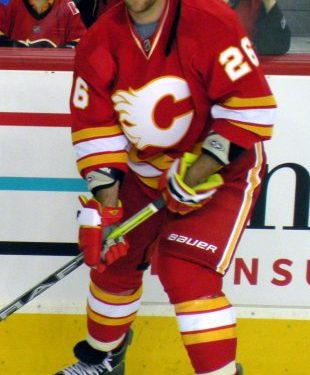Calgary Flames defenseman Dennis Wideman was originally suspended 20 games for delivering a check to the back of the head of linesmen Don Henderson in a game on Jan. 27. Wideman had just recently been checked violently to the ice and appeared to be out of sorts, but it did not stop him from aggressively hitting Henderson in the back, a check that we know now will keep the linesman out for the rest of the season. Wideman appealed the suspension, but it was upheld by the NHL on Feb. 17. However, independent arbitrator James Oldham felt differently on the matter, reducing Wideman’s suspension to 10 games this past Friday. This ruling by the independent arbitrator is particularly puzzling and concerning.
In his explanation, Oldham said the NHL did not substantially support its case against Wideman, saying the Flame’s defenseman had no intention to injure Henderson due to his concussed state. Wideman had already been suspended for 19 of the 20 games in his original suspension, and will get back $282,258 of salary he lost from the now nine extra games he missed.
The NHLPA is happy with Oldham’s decision, agreeing that Wideman’s concussed state played a role in his actions, while the NHL is not, saying the message to NHL players and its fans is that “the code of conduct towards officials has changed.” I am on the side of the NHL on this one. While it’s true that Wideman has been a clean player for 11 years in the league, actions of this nature cannot be condoned, especially towards an NHL official. Luckily, the NHL has Rule 40.2, which states a player will be suspended at least 20 games if he does one of three things, one being deliberately striking an official and causing injury. You can look at the video for yourself, but it seemed to me as if Wideman saw exactly who was in front of him and offered no hesitation to let up. In addition the hit has rendered Henderson out for the rest of the season, which is enough to say Wideman’s actions “caused an injury.”
Oldham’s argument is that Wideman could not have possibly intended to injure Henderson in his concussed state. Unfortunately, the other two stipulations of Rule 40.2 emphasize an intent to injure, which does work in Oldham’s ruling favor because he can argue that, while concussed, Wideman did not intend to injure Henderson and could not have possibly attempted to, but that shouldn’t mean that causing an injury to a defenseless official should be taken lightly.
I’m glad that Wideman was still given a 10-game suspension, showing that this type of behavior will not be tolerated. But, if a player who is hit hard on the ice proceeds to recklessly hit a player – or worse another official – and then later cites concussion-like symptoms as the reason for his actions, Oldham’s ruling proves that players could possibly get away with cheap shots and dangerous hits, which is not the impression the NHL wants to portray to its officials or fans.





